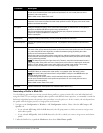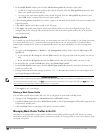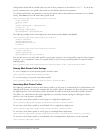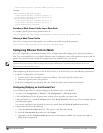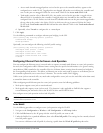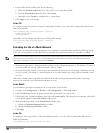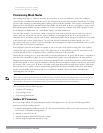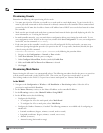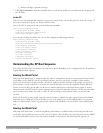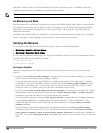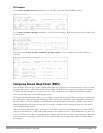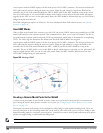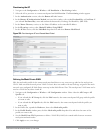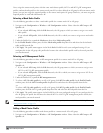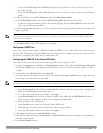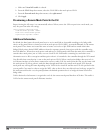
l Antenna tilt angle (optimum coverage)
5. Click Apply and Reboot. After the controller reboots, mesh cluster profiles are extracted from the AP group and
the AP name.
In the CLI
When you use the command-line interface to reprovision a mesh node, you may also provision other AP settings. To
provision a remote mesh portal, see “Remote Mesh Portals”.
Access the CLI in config mode and issue the following commands:
(host)(config) #provision-ap
read-bootinfo ap-name <name>
mesh-role {mesh-point|mesh-portal}
reprovision ap-name <name>
If you are provisioning an outdoor AP, you can also configure the following parameters:
(host)(config) #provision-ap
read-bootinfo ap-name <name>
mesh-role {mesh-point|mesh-portal|remote-mesh-portal}
a-ant-bearing <bearing>
a-ant-tilt-angle <angle>
g-ant-bearing <bearing>
g-ant-tilt-angle <angle>
altitude <altitude>
latitude <location>
longitude <location>
reprovision ap-name <name>
Understanding the AP Boot Sequence
The section describes the boot sequence for mesh APs in detail. Depending on its configured role, the AP performs a
slightly different boot sequence.
Booting the Mesh Portal
When the mesh portal boots, it recognizes that one radio is configured to operate as a mesh portal. It then obtains
an IP address from a DHCP server on its Ethernet interface, discovers the master controller on that interface,
registers the mesh radio with the controller, and obtains regulatory domain and mesh radio profiles for each mesh
point interface. A mesh virtual AP is created on the mesh portal radio interface, the regulatory domain and radio
profiles are used to bring up the radio on the correct channel, and the provisioned mesh cluster profile is used to
setup the mesh virtual AP with the correct announcements on beacons and probe responses. On the non-mesh radio
provisioned for access mode, that radio is a thin AP and everything on that interface works as a thin AP radio
interface.
If the 802.11a/802.11g radio profile assigned to the mesh radio is enabled, the radio supporst both mesh backhaul
and client access Virtual APs. If the mesh radio is to be used exclusively for mesh backhaul traffic, associate that
radio to a dedicated 802.11a/802.11g radio profile with the radio disabled so the mesh radios carry backhaul traffic
only.
Booting the Mesh Point
When the mesh point boots, it scans for neighboring mesh nodes to establish a link to the mesh portal. All of the
mesh nodes that establish the link are in the same mesh cluster. After the link is up, the mesh point uses the DHCP
to obtain an IP address and uses the same master controller as their parent. The remaining boot sequence, if
DellPowerConnectW-SeriesArubaOS6.2 | User Guide SecureEnterpriseMesh | 469



